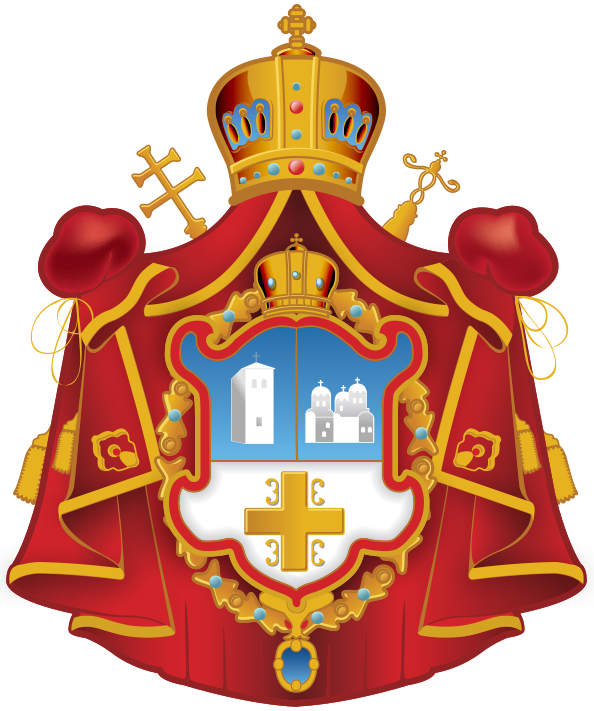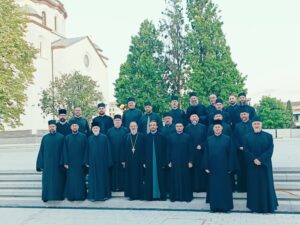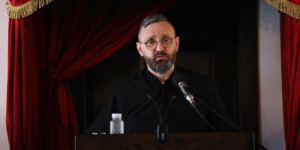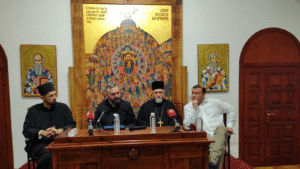Dedicated to the English-language edition of the monography Nikola Tesla – A Spiritual Portrait by Presbyter Dr. Oliver Subotić.
In contemporary society, where even our mental focus has become a commodity, not even the name of Nikola Tesla has been spared from commercial and political instrumentalisation. The cult surrounding him—carefully nurtured through decades of glorification—has become a convenient vehicle for various agendas, ranging from marketing and branding to pseudo-religious myth-making and political point – scoring.
On the commercial level, Tesla’s name is used to sell almost anything: from cars and technology to energy drinks, clothing, and souvenirs. While it may be legitimate to use a scientist’s name to promote innovation, the problem arises when Tesla is exploited simply as a meaningless symbol—a label for “visionary thinking” devoid of actual substance. His name becomes marketing currency, but without any commitment to truth, science, or Tesla’s ideas. His real work is seldom mentioned; it is more important to associate a product with the myth of genius and “futuristic visions” than to explore the actual content of his scientific achievements. Tesla, who died destitute and alone, far removed from the world of commerce and politics, is now being used to promote the very rationale that drives power and profit, as well as the accompanying identity which he spent his whole life renouncing. In this sense, the greatest irony may be that the mythology surrounding his name and naked commercialism—areas which once ignored or exploited him—have now claimed him as their own. Tesla, by his work, earned his place among the greats of science, but it borders on blasphemy that in today’s society, he is increasingly honoured not for what he actually achieved, but for what the myth about him enables others to achieve.
The cult of Nikola Tesla has in recent decades often moved beyond healthy admiration and entered the realm of mythology. Tesla is portrayed as a misunderstood prophet of science, a solitary genius, a victim of malevolent industrialists, and a guardian of “forbidden knowledge.” Such depictions rarely arise from genuine study of his work but rather from society’s desire, in times of chaos, to find a figure of idealised, pure, and almost saintly character—someone who did not labour for profit, but for the benefit of humanity.
This idealisation is further reflected in the emergence of so-called Teslians—individuals and groups who present themselves as Tesla’s intellectual and spiritual heirs. It is typical of them to form civil associations for the protection of Tesla’s image and legacy, creating an impression of genuine reverence for the great inventor. However, upon closer inspection, this loyalty is often found to be rooted not in an understanding of his scientific work, but in myths, speculations, and personal projections. „Teslians“ are frequently without education in the natural sciences and do not engage in any serious research within their respective professions. Their interest in Tesla is often superficial, selective, and riddled with sensationalism. They invoke his name to legitimise their own ideas—which range from alternative medicine and anti-gravity, to cosmology, ufology, and “free energy”—none of which is supported by experimental evidence or scientific method. Their version of Tesla is a fantasy, a projection of their own desire for “revolution” and “hidden truths,” while the real Tesla—a scientist, an experimenter, a man who laboured in the laboratory night and day—fades from view.
Though perhaps motivated by sincere admiration, many Teslians in fact contribute to the banalisation of science. Instead of promoting education, they spread vague ideas often rooted in conspiracy theories. Their “faith” in Tesla frequently goes against the very principle of science: verifiability and openness to correction. Teslians often speak of “forbidden discoveries,” “hidden patents,” and “secrets Tesla took to the grave.” They present him less as a scientist whose contributions are grounded in experiment and rational thought, and more as a fighter against “the system,” a victim of conspiracies by powerful elites.
Within Teslianism, we find a convergence of mythomania, pseudoscience, and pseudo-religion, complete with cultic elements. This represents a total departure from Tesla’s actual way of life, his value system, and the very essence of his scientific method—which was thoroughly rational, open to constant testing, reliant on experimental verification, and never dogmatised. In the Teslian narrative, he is no longer a researcher, but rather a symbol of resistance, a hero of alternative knowledge, an occult figure, and ultimately a spiritual leader and visionary of the future.
Tesla is promoted as a seer and prophet of a new “Teslian religion”—the religion of the future. Within this framework, Tesla is its founder and archpastor, and Teslians are its apostles and interpreters. They appropriate ideas from certain New Age circles, presenting Tesla as a medium through whom “higher intelligences” communicated knowledge. Misattributed quotes such as “If you want to find the secrets of the universe, think in terms of energy, frequency and vibration” are often used as a foundation for interpreting the world through the lens of vibrations, chakras, “energy fields,” and “cosmic consciousness.”
The result is that Tesla is portrayed as a prophet and founder of a divine science—a “scientist” who supposedly validates spiritual theses. A “spiritual physicist” who allegedly proved that everything in the universe is connected through “ether” or “astral energy.” All of this is seen by his admirers as evidence that he was a “messenger of truth” who tried to restore humanity’s contact with divine realities, but was thwarted by “dark forces” (financial oligarchy, scientific establishment, secret societies, the Vatican…). Finally, the authority of the great inventor is also exploited in the realm of alternative medicine and so-called “spiritual healing.” Under Tesla’s name, numerous pseudo treatments have emerged: space harmonisation, aura cleansing, energy detoxification, healing of auric blockages, guided meditations… None of these practices have any medical basis. The only guarantee of quality is the deception that these are “Tesla’s methods.”
It is important to note that Teslians, in their spiritual delusions, systematically minimise the role of Orthodox Christian teachings and values in Tesla’s unquestionably virtuous life. Teslianism prefers a vague, mystified version of his spirituality—one more compatible with their spiritual imagination, thus negating his Orthodox Christian roots. The great inventor is presented as a proponent of mysticism and Far Eastern religions, especially Buddhism. His relationships and correspondence with Eastern gurus—most notably Swami Vivekananda—are portrayed as central to his worldview. Teslian “dogmatics” in recent years have even extended into UFO theories, speculations about “secret Tesla weapons,” and, most dangerously, into the field of alternative medicine, where charlatan and pseudo-therapeutic methods are proliferating without any medical accreditation or supervision. Occult techniques and esoteric practices, especially spiritism, are becoming increasingly common. Everything is justified by references to “Tesla’s visions,” even though he himself explicitly rejected spiritualist practices, considering them a form of charlatanism.
The activities of Teslians have been accompanied by prolific publishing efforts, with public promotions and panel discussions regularly organised, and their presence in media and on social networks steadily increasing. Their entry into our homes and spheres of interest is facilitated by the fact that certain members of the academic community have willingly participated in this “idealised” representation of Tesla. In fact, with their exalted appearances, some have taken the lead in the unnecessary and harmful ideologisation of his legacy. This expansion has also been bolstered by special guests from abroad. Following the well-known maxim “like attracts like,” various thematically selected conspiracists, “alternative thinkers,” “academics,” and “ufologists” are invited from across the globe, adding a sense of “credibility” and contributing to the multifaceted construction of Nikola Tesla’s public image.
The average viewer generally finds it difficult to follow, let alone verify, the content presented in the speeches and “sermons” of the Teslians—whether at public panels, book promotions, or in the media. It is likewise difficult to oppose their positions without appearing either intellectually deficient—incapable of understanding Tesla’s “messages”—or simply hostile. As a result, their narratives, concepts, and messages are often accepted without critical reflection.
This may be hard to accept, but we must acknowledge that we actually know very little about Tesla’s religiosity and spiritual aspirations. If we truly wish to honour Nikola Tesla, we must stop worshipping him and start understanding him—not through legends, but by analysing the historical context in which he lived, worked, and conducted his research, especially his ideas, which, despite everything, were—and remain to be—dedicated to the betterment of humanity’s future. Instead of becoming an object of education and critical inquiry, Tesla’s legacy is being transformed into a tool of mythology, commercialisation, and self-promotion. This does not serve to elevate his greatness; rather, his name is being used to legitimise pseudo-scientific and para-religious ideologies he himself never advocated. Tesla was a brilliant mind, but also a human being with weaknesses, failures, and errors in judgment. True honour lies not in his mystification, but in the effort to understand the context of his work and to extract from his ideas that which remains relevant to science—not to the sale of illusions.
Tesla’s intellectual curiosity, passion for discovery, and spiritual breadth made him a worthy interlocutor in conversations and exchanges with spiritual teachers from the East, among others, especially those who visited North America in the wake of the 1893 World Parliament of Religions in Chicago. Courteous and informed communication with Eastern thinkers did not compromise his personal ethical code, which was deeply rooted in Orthodox Christianity. It is true that Nikola Tesla expressed a profound interest in Eastern philosophy and spirituality, in Hindu concepts of energy and vibration, and even in certain aspects of Eastern metaphysics. Nonetheless, his reflections on religion show that he expressed the highest esteem for Christianity, which he identified as the only experimentally verified religion—unlike others, which he regarded as products of abstract speculation.
This is also confirmed by Bishop Nikolaj Velimirović (himself a student of Eastern spirituality), with whom Tesla exchanged views and to whom he once said that he had studied all the world’s religions and had come to the conclusion that Christianity was the most practical. Tesla, therefore, did not equate religious systems; rather, he affirmed the ultimate superiority of Christianity.
Milutin Tesla had hoped that his son would follow in his footsteps and become a priest. However, Nikola was called to something entirely different—to become one of the greatest inventors of all time. Though he did not follow his father’s ecclesiastical path, the deep faith he inherited from him, and the religious sensibility he carried with pride throughout his life, remained a vital aspect of his character.
It is also important to highlight that Tesla was deeply respected within the Orthodox Christian community. Although not a “churchgoer” in the traditional sense, he embodied values that the Church frequently upholds: dedication, diligence, research, compassion, and service to others. Because of his achievements, many regarded him as an expert in the „art of living”, who successfully bridged science and spirituality. While Tesla was not known for openly promoting religion, his worldview was deeply informed by spiritual values rooted in the Orthodox tradition.
The idea of identifying, documenting, and presenting previously unknown details that illuminate the spiritual dimension of Nikola Tesla is an invaluable contribution offered to us as readers through the research of Presbyter Oliver Subotić, published in the monography Nikola Tesla – A Spiritual Portrait.
Meticulously substantiated, beautifully written, and systematically organised, the monography provides a clear and well-structured portrait of the great Serbian-born inventor—an undertaking that is far from simple, given the complexity of Tesla’s personality. By tracing the multidimensionality of Tesla’s life and work, the book invites us into many aspects of his existence: his roots, upbringing, and value system; his life philosophies; his work ethic and conduct; his worldview, patriotism, love of freedom—and, finally, his spiritual life, imbued with Christian virtues learned first within the bosom of his own family.
Following the first Serbian-language edition published in 2020, we now have before us the English-language edition: Nikola Tesla – A Spiritual Portrait. In this way, this landmark work by Fr. Oliver Subotić has been made accessible to the international scholars and general public.
What must be especially emphasised is that this research, through its clear argumentation, helps dismantle and neutralise the many unfounded, unnecessary, and often harmful or even malicious interpretations of Tesla’s spiritual life. These are typically the product of ignorant but highly ambitious and commercialised attempts to explain various aspects of the genius’s life.
Zoran Luković
Coordinator of the Section for Apologetics
Missionary Department of the Archdiocese of Belgrade–Karlovci





